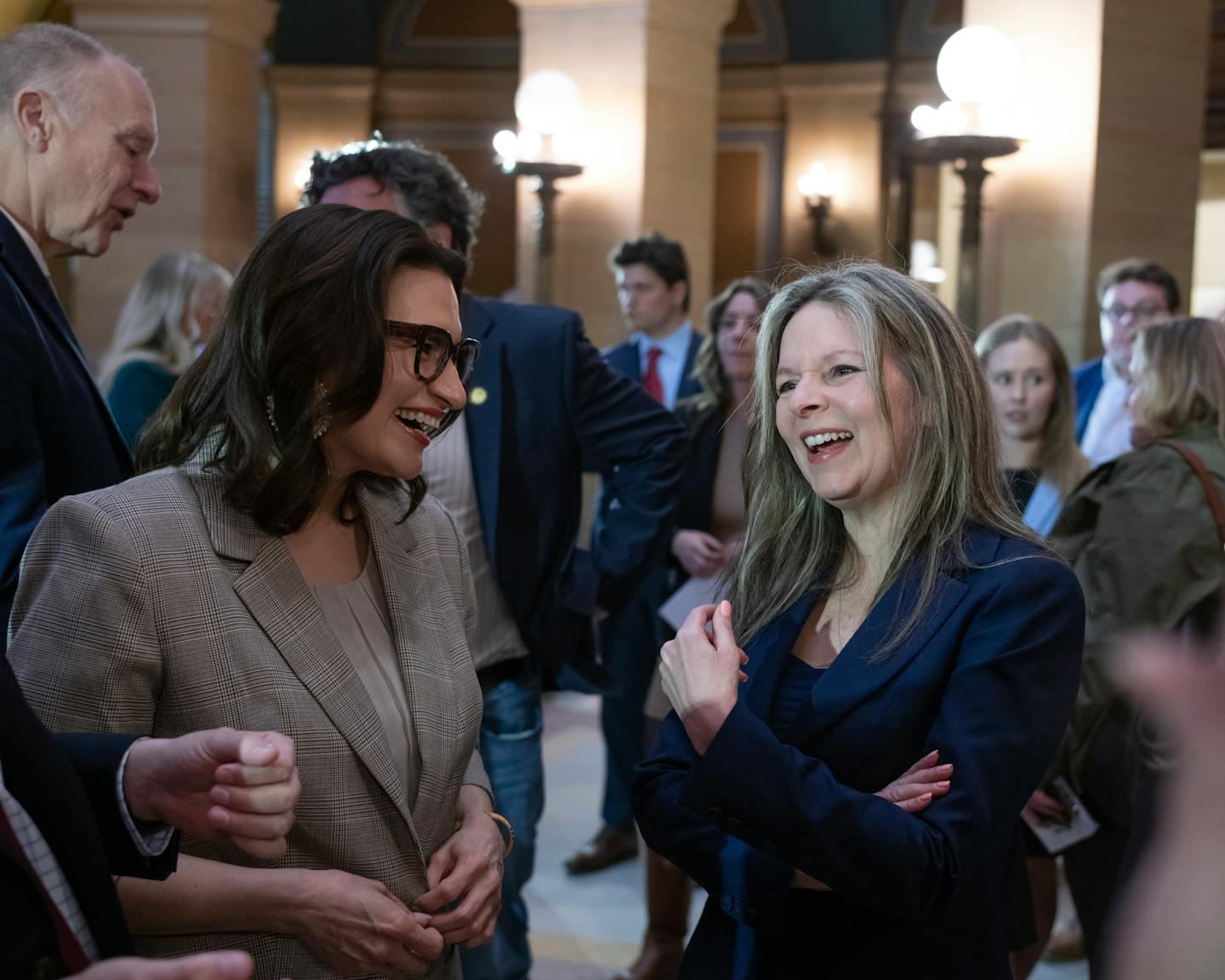Gov. Tim Walz appointed two women to the state Supreme Court on Monday, returning the court to a female majority and elevating two judges with extensive experience in public defense work.
Court of Appeals Judge Theodora Gaïtas and Stearns County Chief Judge Sarah Hennesy will fill the seats held by retiring Justices Margaret Chutich and G. Barry Anderson, respectively. Hennesy will take her seat May 13, the Monday after Anderson steps down. Gaïtas will go on the bench Aug. 1, a day after Chutich departs.
The governor said Hennesy stood out for her "brilliant legal mind," authenticity, "curiosity and care about the world." He also noted that she understands the needs of the state's "smaller counties with limited resources." Her judicial district stretches from Stearns County to the North Dakota border.
Walz then turned to his first appointee to the state Supreme Court, Gordon Moore, the justice who came from the Nobles County bench based in Worthington. "Justice Moore, you've got a companion on the court," Walz said.
Before he chose the two new justices, Walz spoke with Chief Justice Natalie Hudson about the needs of the court. Adding a justice with appeals court experience was "really, really important," he said she told him.
Walz already knew Gaïtas, whom he referred to as Teddie, because he appointed her to the Court of Appeals four years ago. Before that, she served two years on the Hennepin County District Court bench as an appointee of Gov. Mark Dayton in 2018.
"What always impressed me about her is an understanding that justice is not a one-size-fits-all proposition," he said.
The governor highlighted her 15 years as an appellate criminal public defender, representing an array of defendants from "all walks of life." He said she may be the only justice with substantial experience on both the district and appellate courts.
Chutich and Anderson also came to the high court with appeals court experience as did Hudson. Justice Anne McKeig came from the Hennepin County bench. Justice Paul Thissen is a former DFL speaker of the Minnesota House, and Justice Karl Procaccini served as general counsel to Walz until June 2023.
The appointments return the court to a 4-3 majority women, which Lt. Gov. Peggy Flanagan emphasized in her remarks, saying of young girls that they should "dream big. There is a place for her at the Capitol and on the Supreme Court."
Flanagan recalled that Minnesota was the first state in the country with a female majority on the high court when Gov. Rudy Perpich appointed Justice Sandra Gardebring in 1991. Gardebring joined Justices M. Jeanne Coyne, Esther Tomljanovich and Rosalie Wahl, who was the state's first female justice. Wahl, appointed in 1977 by Perpich, retired in 1994.
Until Procaccini's appointment, the court had been a 4-3 female majority since fall 2016 when Dayton named McKeig to the court.
Walz has now appointed four of the seven justices. Both women said it's been important to not be perceived as partisan in their decisions and that they have long track records to back that up.
Mitchell Hamline University School of Law Prof. Peter Knapp called the women strong choices. He was especially pleased with the appellate experience of Gaïtas and the greater Minnesota roots of Hennesy.
In her comments, Hudson praised both women whom she has known for years and said the appointments "marked the end of a period of major transition for our court" in the past six months. "Our court works hard to find common ground on the challenging legal issues that come before us and to work together to achieve the fairest outcomes," she said.
She and Procaccini took on their new roles on Oct. 1. Hudson replaced Chief Justice Lorie Gildea, who retired and works in private practice. Barring unforeseen developments, Walz isn't expected to see another opening on the court in the next couple of years.
The two new justices said they spoke to each other for the first time Sunday when Gaïtas called Hennesy, with the greeting, "This is your new best friend."
In her comments at the Capitol rotunda, Gaïtas noted Chutich and Anderson in the front row and said, "You are really, really tough acts to follow."
Both women spoke movingly about their personal backgrounds.
"I still get shivers when I walk into that spectacular Supreme Court courtroom here at the Capitol," Gaïtas said as her daughter Clea Gaïtas Sur looked on. Gaïtas also mentioned her late husband, whom she described as "the incomparable Chris Sur," who died suddenly while cross-country skiing last year.
Gaïtas, 53, was born in Minneapolis to parents who met at Winona State University. Her mother is a native Minnesotan and her father is from Greece. She grew up in Athens before returning to attend the University of Minnesota, from which she earned her bachelor of arts and law degrees.
She speaks Greek, and Hennesy, who worked in the Basque region of Spain, speaks Spanish. Hennesy, 54, nodded to her parents, who were in the audience. She said her father was a high school teacher and the family lived in Melbourne, Australia, for several years before returning to Iowa.
Hennesy recalled her fears as a first-year law student at Drake University in Des Moines when she saw a course called torts. "It was a word I had never seen before and I was worried that I might not be good enough, might not be smart enough to do the work at law school," she said, adding that she's not forgotten how "entirely unnavigable the system looks from the outside."
The appointments do not require state Senate confirmation. The justices will have to stand for statewide election, but not until 2026.






